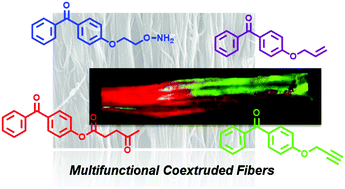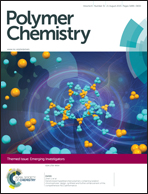Multifunctional and spatially controlled bioconjugation to melt coextruded nanofibers†
Abstract
Polymeric fibers have drawn recent interest for uses in biomedical technologies that span drug delivery, regenerative medicine, and wound-healing patches, amongst others. We have recently reported a new class of fibrous biomaterials fabricated using coextrusion and a photochemical modification procedure to introduce functional groups onto the fibers. In this report, we extend our methodology to control surface modification density, describe methods to synthesize multifunctional fibers, and provide methods to spatially control functional group modification. Several different functional fibers are reported for bioconjugation, including propargyl, alkene, alkoxyamine, and ketone modified fibers. The modification scheme allows for control over surface density and provides a handle for downstream functionalization with appropriate bioconjugation chemistries. Through the use of multiple orthogonal chemistries, fiber chemistry could be differentially controlled to append multiple modifications. Spatial control on the fiber surface was also realized, leading to reverse gradients of small molecule dyes. One application is demonstrated for pH-responsive drug delivery of an anti-cancer therapeutics. Finally, the introduction of orthogonal chemical modifications onto these fibers allowed for modification with multiple cell-responsive peptides providing a substrate for osteoblast differentiation.

- This article is part of the themed collection: Emerging Investigators

 Please wait while we load your content...
Please wait while we load your content...